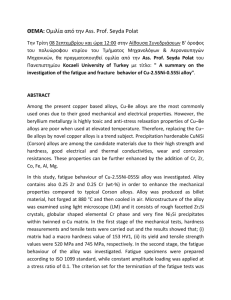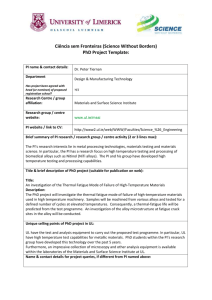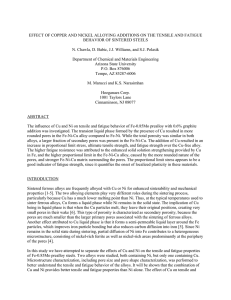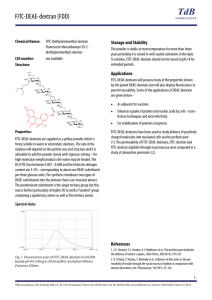EFFECT OF COPPER AND NICKEL ALLOYING ADDITIONS ON THE TENSILE... BEHAVIOR OF SINTERED STEELS
advertisement
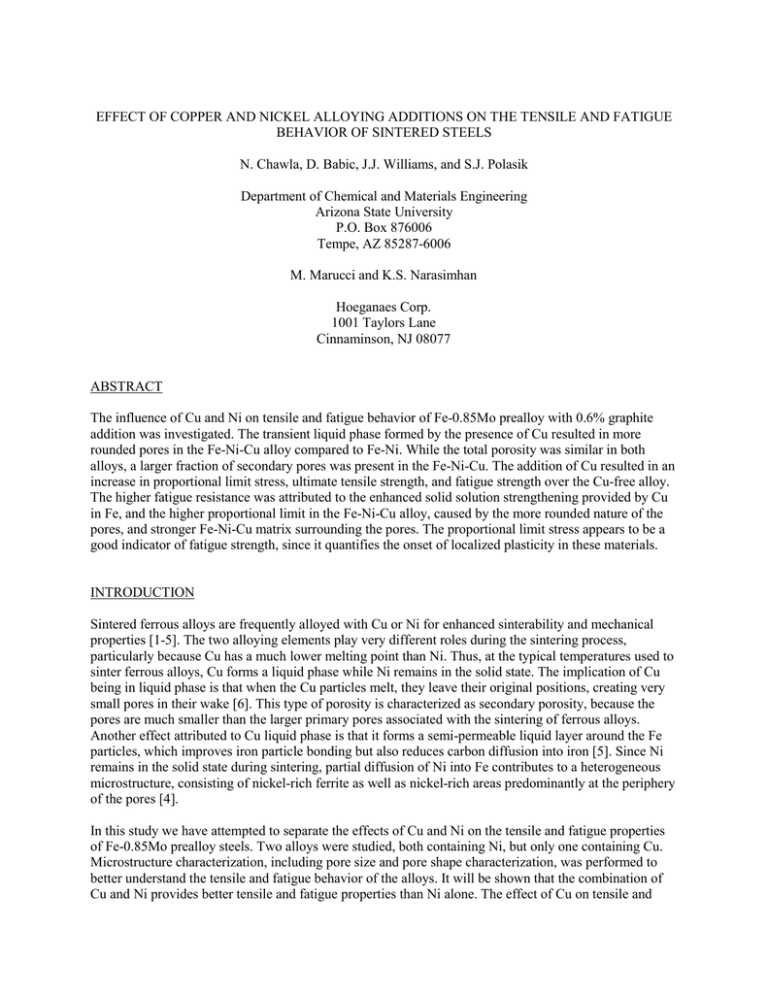
EFFECT OF COPPER AND NICKEL ALLOYING ADDITIONS ON THE TENSILE AND FATIGUE BEHAVIOR OF SINTERED STEELS N. Chawla, D. Babic, J.J. Williams, and S.J. Polasik Department of Chemical and Materials Engineering Arizona State University P.O. Box 876006 Tempe, AZ 85287-6006 M. Marucci and K.S. Narasimhan Hoeganaes Corp. 1001 Taylors Lane Cinnaminson, NJ 08077 ABSTRACT The influence of Cu and Ni on tensile and fatigue behavior of Fe-0.85Mo prealloy with 0.6% graphite addition was investigated. The transient liquid phase formed by the presence of Cu resulted in more rounded pores in the Fe-Ni-Cu alloy compared to Fe-Ni. While the total porosity was similar in both alloys, a larger fraction of secondary pores was present in the Fe-Ni-Cu. The addition of Cu resulted in an increase in proportional limit stress, ultimate tensile strength, and fatigue strength over the Cu-free alloy. The higher fatigue resistance was attributed to the enhanced solid solution strengthening provided by Cu in Fe, and the higher proportional limit in the Fe-Ni-Cu alloy, caused by the more rounded nature of the pores, and stronger Fe-Ni-Cu matrix surrounding the pores. The proportional limit stress appears to be a good indicator of fatigue strength, since it quantifies the onset of localized plasticity in these materials. INTRODUCTION Sintered ferrous alloys are frequently alloyed with Cu or Ni for enhanced sinterability and mechanical properties [1-5]. The two alloying elements play very different roles during the sintering process, particularly because Cu has a much lower melting point than Ni. Thus, at the typical temperatures used to sinter ferrous alloys, Cu forms a liquid phase while Ni remains in the solid state. The implication of Cu being in liquid phase is that when the Cu particles melt, they leave their original positions, creating very small pores in their wake [6]. This type of porosity is characterized as secondary porosity, because the pores are much smaller than the larger primary pores associated with the sintering of ferrous alloys. Another effect attributed to Cu liquid phase is that it forms a semi-permeable liquid layer around the Fe particles, which improves iron particle bonding but also reduces carbon diffusion into iron [5]. Since Ni remains in the solid state during sintering, partial diffusion of Ni into Fe contributes to a heterogeneous microstructure, consisting of nickel-rich ferrite as well as nickel-rich areas predominantly at the periphery of the pores [4]. In this study we have attempted to separate the effects of Cu and Ni on the tensile and fatigue properties of Fe-0.85Mo prealloy steels. Two alloys were studied, both containing Ni, but only one containing Cu. Microstructure characterization, including pore size and pore shape characterization, was performed to better understand the tensile and fatigue behavior of the alloys. It will be shown that the combination of Cu and Ni provides better tensile and fatigue properties than Ni alone. The effect of Cu on tensile and fatigue behavior will be discussed in terms of: (a) Cu as a strengthening agent in the Fe particles and (b) Cu liquid phase effect on pore morphology, size, and distribution. EXPERIMENTAL PROCEDURE Two Fe-0.85Mo alloys were investigated in this study, both containing approximately the same amount of Ni and graphite, Table 1. The Fe-Ni-Cu alloy contained 1.5 % of copper, while the Fe-Ni alloy did not contain any copper. Table 1. Composition of powder metallurgy alloys examined in this study. Alloy Fe-Ni-Cu Fe-Ni Mo 0.85 0.85 Composition (wt. %) Cu Ni C 1.50 1.75 0.60 0.00 2.00 0.60 Fe Balance Balance The powders were blended and binder treated using a proprietary process developed by Hoeganaes Corp. [7,8]. All powders were pressed into rectangular blanks, to a green density of 7.0 g/cm3, and sintered at 1120ºC for 30 minutes in a 90% N2–10% H2 atmosphere. In order to characterize the pore structure, both the pore size and pore shape distributions were quantified. Analysis of primary pores (taken as pores with areas above 25 µm2) was taken from digital image analysis of optical micrographs of the samples’ crosssection. The smaller, secondary pores (taken as pores with areas smaller than 25 µm2) were analyzed by scanning electron microscopy (SEM). Pore size was estimated by measuring the pore area fraction, while pore shape was characterized by a pore shape factor, F [5]: F= 4πA P2 where A and P are the measured pore area and measured pore perimeter, respectively. In the analysis of the pore shape factor a value of 1 denotes a perfectly circular pore, and values that approach zero denote increasingly irregular pores. Tensile and fatigue testing were conducted on cylindrical axial specimens machined from the sintered rectangular blanks. The specimens had to an overall length of 75 mm, gage length of 20 mm, and gage diameter of 4.75 mm. Specimens were hand polished, using diamond paste, to a 1 µm finish. Tensile tests were conducted at a constant strain rate of 10-3/s, while axial fatigue testing was conducted at an R ratio (σmin/σmax) of –1, and a sinusoidal frequency of 40 Hz. All mechanical testing was conducted on a precision aligned servohydraulic load frame. SEM and energy dispersive spectroscopy (EDS) were performed for fracture surface analysis and compositional analysis, respectively. RESULTS AND DISCUSSION The sintered density of both alloys was about 7.0 g/cm3 and the dimensional change after sintering was also similar, Table 2. Microstructural analysis revealed that porosity in both alloys to be about 12%, which was consistent with the density of the alloy relative to the pore-free density. While the total porosity was similar, optical micrographs of both alloys, Fig. 1, revealed a larger fraction of secondary pores in the Cu-containing alloy. This was to be expected, as mentioned in the introduction, since the Cu formed a transient liquid phase during sintering and left the secondary pores in its wake. Table 2. Sintered properties of Fe-0.85Mo alloys. Alloy Fe-Ni-Cu Fe-Ni (a) Green Density (g/cm3) 7.05 6.97 Sintered Density (g/cm3) 7.01 6.98 Dimensional Change (%) -0.06 0.02 Pore area fraction (%) 12.0 12.1 (b) Figure 1. Optical micrographs of as-sintered microstructure: (a) Fe-Ni-Cu and (b) Fe-Ni alloy. Note the higher degree of secondary porosity in the Cu-containing alloy. The absence of a large amount of dimensional change in the Cu-containing alloy can be explained by the competing mechanisms of (a) transient liquid phase formation and diffusion of this phase into Fe particles [6] and (b) formation of secondary pores formed by the liquid phase [9]. The absence of liquid phase in the Fe-Ni alloy resulted in an almost negligible dimensional change. Scanning electron microscopy of the polished surfaces further indicated that Ni did not diffuse completely into iron and was present predominantly at the periphery of the primary pores in both alloys, Fig. 2. Figure 2. Backscattered scanning electron micrograph showing nickel-rich areas from incomplete diffusion of Ni (bright regions in the micrograph), predominantly around primary pores. The pore size and distribution analysis quantified primary pores (> 25 µm2) and secondary pores (< 25 µm2) separately. A comparison of the primary pore size and pore shape distribution for both alloys is Figure 5. Pore shape versus pore size relationship in both alloys, indicating that pores in the Cu-containing alloy were more rounded. The tensile behavior of the alloys was profoundly influenced by the presence of Cu, Table 3. The Cucontaining alloy exhibited higher proportional limit stress (the stress defined as the onset of plasticity in the material, taken here as 1% deviation in linearity of the stress-strain curve) and higher ultimate tensile strength. The Young’s moduli of the alloys were similar, since both alloys contained the same relative porosity. The higher tensile strength in Fe-Ni-Cu can be attributed to the presence of Cu in solid solution, which is effective in increasing the resistance to dislocation motion and increasing the work-hardening rate of the alloy. The higher proportional limit was also affected by the presence of Cu in solid solution, but may have been more influenced by the more rounded nature of pores in the Fe-Ni-Cu. The stress concentration at a spherical pore is clearly less severe than that of a very irregular pore. Fractographic analysis of tensile fracture surface of both alloys was characteristic of most sintered ferrous powder metallurgy alloys, Fig. 7, showing evidence of localized ductile rupture of sintered bonds. Alloy Fe-Ni-Cu Fe-Ni Table 3. Tensile behavior of Fe-Ni-Cu and Fe-Cu alloys. Young’s Proportional Limit Ultimate Tensile Modulus Stress Strength (GPa) (MPa) (MPa) 135 221 797 131 190 570 Strain-to- Failure (%) 1.91 2.12 CONCLUSIONS The mechanical behavior of binder-treated Fe-0.85Mo prealloy with Cu, Ni, and graphite additions was investigated. In particular, the effect of Cu on tensile and fatigue behavior was studied, yielding the following conclusions: 1. The transient liquid phase formed by the presence of Cu resulted in more rounded pores in the Fe-NiCu alloy compared to Fe-Ni. While the total porosity was similar in both alloys, a larger fraction of secondary pores was present in the Fe-Ni-Cu. 2. The addition of Cu resulted in an increase in proportional limit stress and ultimate tensile strength over the Cu-free alloy. Copper diffusion into iron seems to contribute to enhanced resistance to dislocation motion resulting in an increase in work hardening rate over the Fe-Ni alloy. Both alloys exhibited similar fracture mechanisms, consisting primarily of ductile rupture at sintered particle bonds. 3. Fe-Ni-Cu alloy had a higher fatigue resistance than the Fe-Ni alloy. The higher fatigue resistance can be attributed to the enhanced solid solution strengthening and more rounded pores provided by Cu in Fe, particularly since the amount of primary porosity in both materials was similar. The proportional limit stress appears to be a good indicator of fatigue strength, since it quantifies the onset of localized plasticity in these materials. ACKNOWLEDGMENTS The authors would like to thank Hoeganaes Corp. for financial support of this work. REFERENCES 1. K.D. Christian, R.M. German, “Relation Between Pore Structure and Fatigue Behavior in Sintered Iron-Copper-Carbon”, Int. J. Powder Metall., Vol.31, No.1, 1995, pp.51-61. 2. S. Carabajar, C. Verdu, A. Hamel, R. Fougeres, “Fatigue Behavior of a Nickel Alloyed Sintered Steel”, Mater. Sci. Eng., Vol.A257, 1998, pp.225-234. 3. H. Drar, A. Bergmark, “Initial Fracture Mechanisms in Nickel Alloyed P/M Steel”, Fatigue Fract. Eng. Mater. Struct., Vol.20, No.9, 1997, pp.1319-1330. 4. S.J. Polasik, J.J. Williams, N. Chawla, “Fatigue crack initiation and propagation of binder-treated powder metallurgy steels”, Metall. Mater. Trans. A, Vol.33, No.1, 2002, pp.73-81. 5. H. Kuroki, G. Han, K. Shinozaki, “Solution-reprecipitation mechanism in Fe-Cu-C during liquid phase sintering”, Int. J. Powder Metall., Vol.35, No.2, 1999, pp.57-62. 6. R.M. German, Liquid Phase Sintering, Plenum Press, New York, 1985, p. 22. 7. F.J. Semel, “Properties of Parts Made from ANCORBOND Processed Carbon-Nickel-Steel Powder Mix”, Adv. Powder Metall. Part. Mater., Metal Powder Industries Federation, Princeton, NJ, 1989, p.9. 8. S.H. Luk, J.A. Hamill Jr., “Dust and Segregation-Free Powders for Flexible P/M Processing”, Adv. Powder Metall. Part. Mater., Metal Powder Industries Federation, Princeton, NJ, 1993, p.153. 9. H. Danninger, “Pore Formation During Sintering of Fe-Cu and Its effects on Mechanical Properties”, Powder Metall. Int., Vol.19, No.1, 1987, pp.19-23. 10. T. Yokoi, M. Takahashi, N. Maruyama, M Sugiyama, “Cyclic Stress Response and Fatigue Behavior of Cu Added Ferritic Steels”, J. Mater. Sci., Vol.36, 2001, pp.5757-5765. 11. D.A Gerard, D.A. Koss, “Low Cycle Fatigue Crack Initiation: Modeling the Effect of Porosity”, Int. J. Powder Metall., Vol.26, No.4, 1990, pp.337-343. 12. H. Danninger, D. Spoljaric, B. Weiss, “Microstructural Features Limiting the Performance of P/M Steels”, Int. J. Powder Metall., Vol.33, No.4, 1997, pp.43-53. 13. J. Holmes, R.A. Queeney, “Fatigue Crack Initiation in a Porous Steel”, Powder Metall., Vol.28, No.4, 1985, pp.231-235. 14. U. Lindstedt, B., Karlsson, R. Masini, “Influence of Porosity on Deformation and Fatigue Behavior of P/M Austenitic Stainless Steels”, Int. J. Powder Metall., Vol.33, No.8, 1997, pp.49-61. 15. K.V. Sudhakar, “Fatigue Behavior of a High Density Powder Metallurgy Steel”, Int. J. Fatigue, Vol.22, 2000, pp.729-734. 16. H. Drar, “Metallographic and Fractographic Examination of Fatigue Loaded P/M-Steel With and Without MnS Additive”, Mater. Charact., Vol.45, 2000, pp.211-220. 17. D. Rodzinak, M. Slesar, “The Fatigue Curve of Sintered Iron and its Microstructural and Fractographic Interpretation”, Powder Metall. Int., Vol.12, No.3, 1980, pp.127-130.

